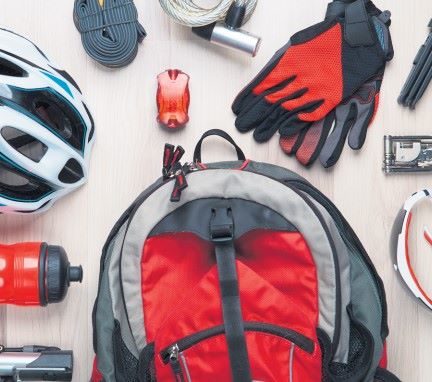
[By Katrina Kardos, MD, Medical Director, Emergency Department at Samaritan Hospital.]
According to the most recent figures from the U.S. Department of Transportation, approximately 1,000 bicyclists will be killed in crashes with motor vehicles this year, while another 42,000 will be injured. The numbers have been steadily rising over the past decade, highlighting the need for increased awareness among motor vehicle operators and their responsibility to safely share the road with cyclists.
For cyclists, it also underscores the importance of having the right gear to make yourself as visible and safe as possible.
A Well-Fitting Bike Helmet
The rule is simple: If you ride a bike, you need to wear a helmet. According to the Bicycle Helmet Safety Institute, wearing a proper fitting, Consumer Product Safety Commission (CPSC) certified helmet could prevent 85 percent of cyclists’ head injuries in a crash.
Your helmet should be low, level, and snug on your head. To get a perfect fit, put on the helmet and look in a mirror. Your helmet should sit level on your head, and the front of the helmet should cover most of your forehead.
A Properly Fitting Bike
Just as your helmet should have a good fit, so should your bike. An ill-fitting bike can lead to increased risk of injury, including knee pain, neck or lower back pain, and numbness in the hands. It also can lead to an increased chance of losing control of the bike during evasive maneuvers. For the best fit, the saddle (seat) should be at a height where there is a slight bend in your knee when the leg is straightened while pedaling.
Obey the Rules of the Road
Once you are on the road, remember to ride WITH the flow of traffic and obey the rules of the road. Be extra cautious when riding across parking lots or driveways. Cars can pull in or out unexpectedly or back up without seeing you.
Safety/Essential Accessories
A high visibility/reflective vest can make you more conspicuous to drivers. There are numerous LED bike headlights that are rechargeable, many with a strobe feature to increase visibility. Please remember to bring plenty of water and sunscreen. You should also carry identification, your phone, an extra tire tube in case of a flat, and an air pump to reinflate the new tube.
 These rules are not just for traditional cyclists. E-bike popularity is on the rise and, although they may look like regular bikes, they include an electric motor and rechargeable battery. They come in three classes, depending on whether they have a throttle and the maximum speed they can reach.
These rules are not just for traditional cyclists. E-bike popularity is on the rise and, although they may look like regular bikes, they include an electric motor and rechargeable battery. They come in three classes, depending on whether they have a throttle and the maximum speed they can reach.
Like their non-motorized counterparts, e-bikes can also result in emergency department visits and deaths. It is important to have the proper skills and training to safely operate an e-bike and to know the local rules/laws regarding riding them.
When every second counts, St. Peter’s Health Partners has top-quality emergency departments and urgent care centers all across the Capital Region. Our emergency departments in Albany and Troy are open 24 hours, seven days a week, offering a wide range of services for emergency care with highly trained staff, diagnostic testing and access to specialists.
For more information, visit us at sphp.com/for-patients/think-before-you-go. Enjoy your summer cycling!





